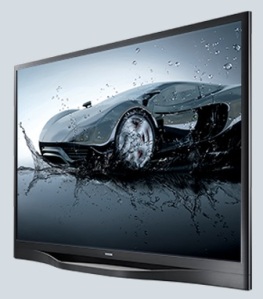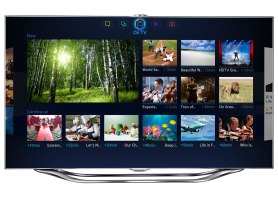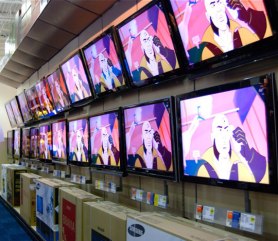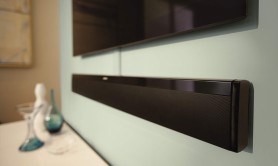2013 TV models from LG, Samsung, Sharp and Toshiba have started trickling into our warehouse and out to our stores. I’m sure they’re hitting other retailers as we speak as well. I hope you’ll stop into one of our stores soon to check out the latest in TV technology, but regardless of where you shop, here are six things you should know before you hit the store.
Full disclosure, the list below does feature a collection of facts and my opinions. The opinions are based on my personal preferences and experience as Grand’s audio-video sales manager since 2004.
1. Shop for Features, Not Sizes.
I counted, and at the time of this printing LG had almost 50 TV models available for us to display and sell. Samsung has even more. There’s no way we can display absolutely everything from every brand we represent – and we’re not alone. Almost every other retailer is in the same boat, even the big guys. Instead, we’ll show as many series of TVs from each manufacturer as we can. A series is a collection of different sized TVs from a brand that share similar features. This allows us to show a wider variety with less actual units on display. Finding the series with the right features allows you to compare your “apples-to-apples” options across all brands.
Let’s say you’re shopping for a 55″ TV with 1080p resolution and smart TV functionality. Find the TVs on display that are 1080p and smart rather than finding the 55″ TVs. As a side note, at Grand, we’ll often have popular sizes like 55″ in stock for all the series represented on our floor even if they’re not displayed on the floor in that particular size.
2. RIP Traditional LCD
That’s right, we already have an obsolete flat panel TV technology. Traditional fluorescent lit LCD panels – commonly referred to simply as LCD TVs – are a thing of the past as none will be available from any of the major manufacturers in 2013. When I heard florescent LCD was gone, I reflected fondly on my first buy as the audio-video buyer here at Grand. It was a shipment of Sharp Aquos 30″ 720p LCD TVs and as I recall, we got such a great deal from Sharp we could sell them at a blistering retail or $2,995 – $500 less than any of our competitors. To put that in the proper perspective, we now sell 39″ 1080p LED TVs starting at $399 and most 60″ LED TVs start at retails of less than that.
Of course, LCD screens will still be used in all 2013 LED TV models.
3. Buying an LED? Up the Hz.
Your TV works like a flip book – it displays a number of still images (called frames) in rapid succession to create the illusion of motion on your screen. Hz refers to the number of frames shown each second. Standard 60Hz LEDs display 60 frames each second; upgraded 120Hz or 240Hz rates double or quadruple that number. The advanced Hz rates were developed to overcome a natural limitation of all LED TVs. The liquid screen in an LED TV takes a moment to respond to motion on the screen. In 60Hz TVs, this creates a shadow or ghosting effect visible to most viewers – particularly with larger screen sizes. Increasing the rate of frames per second reduces or eliminates this issue producing smoother motion on the screen.

60Hz vs. 120Hz
You may be told 120Hz is only needed for viewing fast motion content like sports, movies or video games. However, I argue 120Hz is a must for any TV viewing. Think about the news, for example. Not exactly what you’d consider rapid motion viewing, but definitely what I would consider 120Hz material. Newscasts consist of a heavy dose of close-up views of people’s faces and upper body. You pick up a lot detail viewing in HD and following the motion while maintaining the integrity of the high-detail image can be very difficult for a 60Hz TV – even though the motion is typically slow and deliberate. No one wants to watch a newscaster whose face is a mess of blur every time he or she speaks a word, furrows a brow, etc. Plus, many stations feature a ticker at the bottom of the screen scrolling the day’s breaking news. All that text streaming by is a lot easier to read when you up the refresh rate.
4. Don’t Forget About Plasma
LED is a great technology. It’s the most efficient, slimmest, lightest, brightest and longest lasting technology on the market (apologies to the OLED crowd, it’s not exactly ON the market right now). That said, plasma represents a tremendous value as even ultra premium sets are consistently priced beneath comparably featured LED models.
In addition, pure picture nerds (like me) will always argue plasma has the better picture. To understand why, you have to know a bit about how plasma and LED TVs work. The screen on a plasma TV is made up of millions of pockets filled with plasma gas. The pockets can either be turned on to create colors or turned off to create a deep black. In addition, the plasma gas within each pocket can react instantaneously to changes in the image.
On the contrary, LED screens are made up of a liquid screen that produces an image and an LED light that produces the brightness. The light source is usually on the side of the TV shining inward and is always on.
So why is this all important? Here are the top three reasons:
- Motion Response: In Tip #2 I discussed 60Hz LEDs vs upgraded 120Hz and 240Hz LEDs. Plasma doesn’t differentiate or need different determinants for fast motion. Its all super fast because the plasma pockets can react instantaneously to motion on the screen for a smoother image than any LED.
- Black Levels: Black levels are the basis on which you build a quality picture. If a TV can do deep black, bright white and everywhere in between it can create a vibrant, clear image regardless of what’s on TV. Plus, deep blacks create wider contrast between dark and light so vibrant colors literally pop off the screen. Plasma blacks are better because the pockets can be turned on or off depending on what’s on the screen. You want color, pocket is on. You want black, pocket is off. In an LED, the light source is always on so the TV must mask it in darker areas to create a black, dark gray, etc. In many LEDs, this results in outputs often look more gray or deep purple than black. The best LEDs available can create pretty good black levels, but most still have trouble maintaining the consistency of the black across the panel resulting in “hot spots” of diminished blacks.
- True Color: In the beginning of this section, Tip #3, I mentioned LED is the brightest technology available. LED manufacturers exploit this to overcome objections about inferior black levels. Unfortunately, amping up the brightness in the TV often results diminished color quality. Want to see for yourself, ask the salesperson at your store of choice to put on a sporting event played on a grass field and compare LED vs plasma. I’m pretty confident you’ll see the LED produce more of a neon green while the plasma produces a green more like what you remember – albeit not as bright as the LED.
In fact, in this humble reviewer’s opinion, unless you have $19,999 for LG’s 84″ Ultra LED model 84LM9600, which boasts resolutions four time that of 1080p, Samsung’s much lauded 8500-series plasma TV is the best TV you can buy. It features Samsung’s Super Contrast Panel, which delivers unprecedented brightness, the deepest black levels and precise colors and clarity.
I should note that plasma isn’t the solution for everyone. In general, if you watch daytime TV and your TV faces direct sunlight or you watch more than six hours of TV each day, I’d recommend considering LED. If not, don’t shut the door on plasma.
5. All Smart TVs Are NOT Created Equal
Smart TV is the biggest buzz word on our sales floor. We’re finding more and more consumers that want to be able to access the internet and popular web-enabled services like Netflix, Hulu, YouTube, Facebook, Twitter and Skype through their TV.
If you’re among those interested in these services, I recommend asking to see the Smart TV interface on the TVs you would be interested in purchasing. Look at how fast it loads and how intuitive the menus are to use. This is particularly important if you’re planning to use the Smart TV functions heavily. The faster it loads and easier it is to use, the more you’ll use the functionality.
I’d even recommend considering a Smart TV with quad-core processor for the fastest access to your favorite apps and content. We’re all used to fast load speeds on other smart devices like phones, tablets and computers, shouldn’t we expect the same from our smart TVs.
6. Budget for Sound
Truth be told, TV manufacturers don’t have much motivation to include better sound in their TVs. If you’re shopping for a TV, chances are you’ll find a long wall with dozens of TV sets on display at your retailer of choice. Most consumers will simply pick the best picture for their budget and move on. So, a TV manufacturer is primarily concerned with their picture standing out among the rest – not necessarily ensuring you can actually hear the dialog on your favorite prime time show.
So, while TVs get thinner and brighter to win the aesthetic battle on the sales floor, speakers get smaller and are typically relegated to the back of the TV because they’ve run out of real estate on the front. In order for you to hear the content you’re watching, sound must to come out of the back of the TV, make a U-turn around the TV and make it’s way across the room to your ears in the listening area. I probably don’t need to tell you this doesn’t work very well. The effect is even worse if the TV is mounted on the wall. Imagine turning your back to someone, holding a phone book up to your face and trying to have a conversation.
More bad news, your TV is getting richer content via HDMI than it ever has before. Your cable/satellite box, blu-ray and gaming system is outputting hi-res, multi-channel surround sound audio and your TV is expected to use it’s thin, poorly-placed speakers to decipher that content and send it to you with some sort of clarity. Not a winning combination.
There is some good news, you don’t need to fill your room with bulky, obtrusive speakers and equipment. This sound problem has caused a revolution in the audio industry centered around slim, flat-panel matching solutions for improving the sound quality of your flat panel TV. We carry simple sound solutions quality brands like Polk, Bose and Sonos that will greatly enhance your TV viewing experience. Pricing ranges from approximately $300 to $1500 so there’s something of quality available within most budgets.
Bonus Tip: Check Out the Closeout Deals.
 Last but not least, be open to buying 2012 technology. You can get a great deal on a closeout TV this time of year. Every retailer – Grand included – is discounting old product to make room for 2013 models. Wherever you buy, be sure to check out the closeouts. Often pricing is as good or better than it was on Black Friday. Check out our Liquidation Center to see models we’re currently closing out.
Last but not least, be open to buying 2012 technology. You can get a great deal on a closeout TV this time of year. Every retailer – Grand included – is discounting old product to make room for 2013 models. Wherever you buy, be sure to check out the closeouts. Often pricing is as good or better than it was on Black Friday. Check out our Liquidation Center to see models we’re currently closing out.



